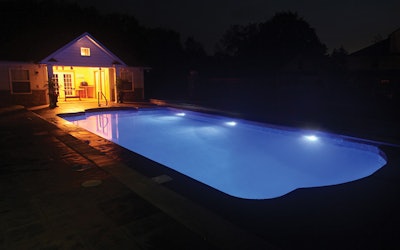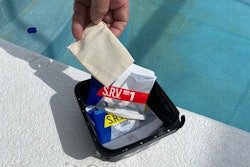
The explosion of LED (light emitting diode) technology can be seen through a variety of lenses, but the story is always the same: LEDs are taking over and revolutionizing the lighting industry across the spectrum of applications, including pools, spas and landscaping.
According to manufacturers serving the aquatics and landscape industries, LEDs now account for well over half of the lighting market for both new installations and the "re-lighting" aftermarket.
On the new construction side of the market, LEDs are widely used on a majority of projects from the very custom high-end down to package pools and everywhere between. In the aftermarket, LEDs are now commonly used to replace existing traditional incandescent, halogen and fiber optic-based systems in pools and spas.
As for the broader lighting industry, Forbes recently cited market research indicating that in 2014, LED sales surpassed $13 billion; by 2020, that number will likely exceed $60 billion. Today, LEDs are the "luminaire" of choice for streetlights, headlights and appliances, as well as security, indoor, landscape and architectural lighting.
WHY SO FAST?
The LED revolution might understandably come as a surprise to someone who hasn't been paying attention, because the growth has been so sudden.
Part of that growth has come as a result of government intervention in the lighting market, specifically the 2007 ban on a number of incandescent light sources, most of which were permanently discontinued at the start of 2014. Since the ban, and in light of consumer demand for energy-efficient products, LEDs have steadily replaced CFL (compact fluorescent) lights, which were the first to benefit from the move away from incandescent lights.
While incandescent lights may be headed for extinction, a few niches remain for other technologies. Low-voltage halogen lights are still being sold in the pool industry and elsewhere, and fiber-optic lighting — once considered the colored light technology of choice for the industry — retains some applications such as band lighting, in which LEDs still come up short due to issues such as pixilation.
But proponents of LED technology are quick to counter that in just the span of a few years, the technology and cost have improved so dramatically that it won't be long before LEDs will be able to effectively replace most forms of lighting, beating its competitors in terms of economics, functionality and aesthetics.
COST BENEFITS
The financial benefits driving LED growth break down into two distinct areas:
Energy efficiency: LEDs typically use only 10 to 15 percent of the power their incandescent and halogen counterparts consume.
Longevity: Incandescent and halogen lights typically boast service lives in the 2,000 to 3,000 hour range. LED service lives are measured in the tens of thousands of hours, with rating numbers ranging from 50,000 to 100,000 hours in many products.
Proponents of the technology are quick to point out that those two factors alone more than offset the often significantly increased cost of LEDs. For pool owners, the energy savings alone can mean a return-on-investment time of less than two years. In commercial applications where lights are used for longer periods day-in, day-out, the ROI may be just a few months.
COLOR SCHEMES
For all of the financial upsides, LEDs are gaining traction for other important reasons, all of which have powerful implications in aquatic applications.
Color: Most any supplier or designer/contractor who uses LEDs are likely to cite color as one of the primary reasons behind the technology's rapid ascent.
Unlike traditional light sources that relied on color gels, color wheels and lenses to create static or changing colors, LEDs use RGB (red, green, blue) combinations to generate color. In some respects, it's similar to the way RGB pixels are used in video applications.
The ways that specific LED lights combine RGB elements at different intensities and configurations can be highly proprietary, but the principle remains basically the same. In most pool and spa applications, a pulsing power "signal" is actuated at a controller that communicates with the LED driver (basically a small circuit board with a microprocessor), which sequences the fixture to the desired color.
Simpler systems, like most of those sold for pool and spa applications, have a relatively small number of colors, while more advanced systems, like those used for choreographed lighting displays, can have colors numbering in the hundreds.
LED proponents also point out that the quality of the color, commonly measured by the CRI (color rendering index) is now superior to traditional lighting technologies, while the light output, typically measured in lumens, is also now either equal to or greater than previous light sources.
Manufacturers confirm that in pools and spas, the appeal of the color flexibility and quality has caught on in a big way with homeowners, due largely to the way that colored light dramatically changes the appearance of man-made bodies of water. Some are also quick to point out that controller technology has now advanced so that pool light colors can be coordinated with landscape lighting outside the pool, creating an even greater wow factor.
DESIGN FLEXIBILITY
While adding color via LED technology carries big appeal with both new construction and re-lighting applications, the overall flexibility and relative ease of installation have dramatically opened up design possibilities.
From the technology's origin, LEDs have been suited for very small lighting applications. As it has grown into other more demanding types of systems, the ability to make small LED fixtures remains important. In fact, some designers say that fact has actually been the biggest game changer of all.
Pools and spas have traditionally been lit using the flood light approach. The familiar single bright light at the deep end shining down the length of the pool has been, and to a large extent remains, the most familiar form of pool lighting.
With their wide spectrum of sizes, easy installation, energy efficiency and longevity, LEDs have encouraged designers and builders to install multiple lights instead of just one or two. The result is endless lighting designs that can be used to accentuate, highlight and articulate internal pool structures, such as tanning shelves, step treatments, swim outs, beach entries or decorative elements such as tile mosaics.
USING RESTRAINT
Given the dramatically increased functionality and design flexibility afforded by LED lights, manufacturers and designers alike caution that in some cases it can be easy to overuse them. It is, after all, possible to shine too much light in a pool or point it in the wrong direction.
In that sense, the advent of LEDs does place a new burden on designers and builders to understand issues such as glare, direction, reflection and intensity. Understanding both the clients' preferences as well as the performance of LED fixtures and control systems will enable optimum use of the technology that is literally changing how we humans light the night.
|
THE RE-LIGHTING MARKETBecause existing pools and spas vastly outnumber new installations in any given year, adapting LED technology to the aftermarket has been a major focus for industry manufacturers. In fact, much of the messaging used to market LEDs to the pool and spa market centers on the idea that changing to LEDs is one of the least expensive ways to significantly upgrade a pool or spa's appearance, at least at night. Given that most pools, especially those built more than 10 years ago, were originally equipped with incandescent and halogen fixtures, pool and spa equipment manufacturers have worked hard to make it easy to adapt LEDs to existing systems. In many cases, the change is as simple as replacing a standard lamp with an LED. Things become a bit more complicated when switching fiber optics systems to LEDs. Because fiber optics systems do not run power to the light source, switching over to LEDs, which require low-voltage lines, requires pulling new power cable. It also means adding new control units at to the illuminators. Again, manufacturers now offer standardized packages designed for that purpose. In terms of overall LED installation, whether existing or new, many of the basic guidelines for traditional lighting installations still apply. For example, although LEDs are considered somewhat less susceptible to voltage drops than high-voltage systems, there are nonetheless maximum recommended distances between the transformer and fixture. And of course, requirements for all power service and basic electrical installation guidelines as defined by the National Electric Code should always be followed to a tee. |
Comments or thoughts on this article? Please e-mail [email protected].
Story based on discussions with David MacCallum, product manager, lights and automation, Pentair Aquatic Systems; Mark Holden, president, Holdenwater; Brett Fritts, vice president and general manager, lighting and EMEA, S.R. Smith; and Jonathan Quon, lighting product manager, S.R. Smith.








































